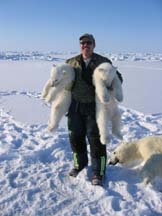 “If you act appropriately and you carry bear spray, you are much better off than just blundering into bear country with a large firearm,” said Brigham Young University researcher Tom Smith in a university press release.
“If you act appropriately and you carry bear spray, you are much better off than just blundering into bear country with a large firearm,” said Brigham Young University researcher Tom Smith in a university press release.
Smith has a paper out in early view in the Journal of Wildlife Management that details the findings of his research into bear attacks in Alaska. He believes his findings apply to bear attacks elsewhere too.
The research confirms some old tips (such as “hike in a large group”), but also has some findings that may be controversial regarding guns versus bear spray — a particularly important topic now that guns are allowed in national parks.
As reported in the Jackson Hole News & Guide, people carrying firearms were more likely to be injured by a charging bear than were people carrying bear spray. The amount of bluff charges against both people carrying either firearms and bear spray is reportedly equal. Apparantly, what happens during the bluff charge is key. And firing a gun seems to drive the bear into a real attack.
Smith says in two different newspaper interviews that when it comes to avoiding injury in bear attacks, it’s not which firearm you carry, but how you carry yourself.
Read one BYU press release with lots of tips through EurekAlert, here.
Read a BYU EurekAlert press release that focuses on debunking bear spray myths, here.
Read the Jackson Hole News & Guide article on the study here.
Read the article in the Billings Gazette, here.
Journal of Wildlife Management article here (fee or subscription required)
Photo: BYU bear biologist Thomas S. Smith published a study on the effectiveness of bear spray for deterring aggressive bears. Here he is pictured with an unconscious “mother” polar bear – “If she were conscious, she’d be holding me,” Smith said. Credit: Thomas S. Smith

Interesting stuff.